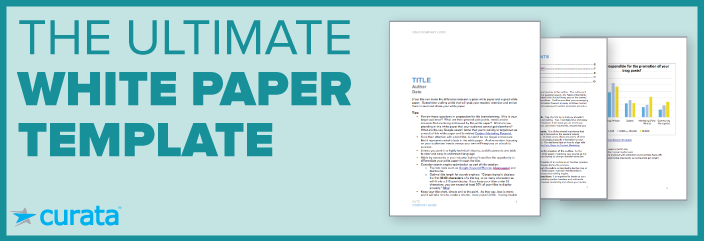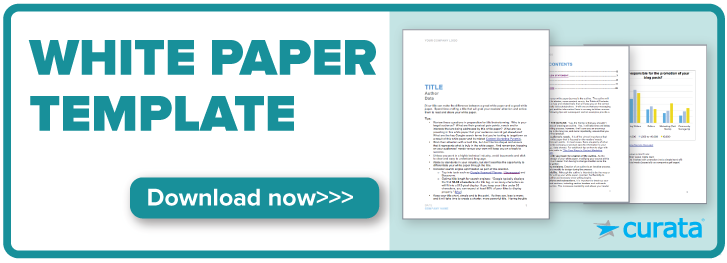- Share The Ultimate White Paper Template [Free Download] on Facebook
- Share The Ultimate White Paper Template [Free Download] on Twitter
- Share The Ultimate White Paper Template [Free Download] on Linkedin
- Share The Ultimate White Paper Template [Free Download] via email
White papers and eBooks should be the foundational assets of any content marketing strategy. The numbers don’t lie, at least in this case:
- White papers are among the top 10 tactics used by B2B content marketers in a CMI study.
- 78% of buyers used white papers in the past 12 months to research B2B purchasing decisions.
Sounds simple, right? Write a white paper to improve the results of your content marketing efforts. If you want to get started now, you can click here to skip down below for a free white paper template. Too simple a directive? Keep reading.

There are a lot more questions to be answered prior to creating a white paper. Here are just a few of them:
White Paper or Whitepaper?
If you guessed “white paper,” you’re correct. At least according to these sources:
According to Google’s data, people get it right roughly 83% of the time.
White Paper: Average monthly searches = 49,500
Whitepaper: Average monthly searches = 9,900
What is a White Paper versus an eBook?
Oh, the roads you will travel in trying to figure this one out. Here’s a quick summary of differences according to Ann Handley and C.C. Chapman from their book, Content Rules:
| eBooks | White Papers |
|---|---|
| Broken into smaller chunks – designed for skimming and scanning | Long and linear – a deep read |
| Concept centric – based on ideas and trends of interest | Data centric – often based on formal research |
| Visually heavy – main text supplemented with call-outs, bullet lists | Text-heavy |
| Casual and collegial – a conversation among equals | Formal – impressive expert speaks to you |
Having worked at IDC for 10 years prior to joining Curata, I prefer to look at eBooks as an evolution of the white paper; at least from a content marketing perspective. Some of Curata’s most downloaded eBooks are in some ways like a white paper according to the above descriptions: data-centric, based on quantifiable research, and deeply researched on a single topic, for example: the 2016 Content Marketing Staffing & Tactics Study. That said, according to the above distinctions, white papers do play a key role in educating and engaging buyers at a deeper level than your typical eBook. (If you do want to write an eBook, read Curata’s Ultimate eBook Template with free download.)
How do I get the Biggest Bang for My White Paper Buck?
Four quick tips to get the most return out of your white paper investment:
- Create your white paper as part of a broader content strategy. A white paper should be fulfilling the objectives of your content strategy—for example:
- building thought leadership in an area that aligns with your product direction.
- addressing the pain points of a particular persona.
- meeting the needs of your audience at a point in the buying cycle.
- achieving “ownership” of a popular search term in Google.
- Optimize the reuse and repurpose of white paper content. Creating a relevant and high quality white paper is a non-trivial endeavor. It would be a waste to simply create this asset, gate it behind a landing page, do some promotion and then move on to the next big project. A strategic way to ensure you get the most out of a white paper is to use the Content Marketing Pyramid framework. This puts a white paper at the top of pyramid, with the content from the white paper atomized into more bite-sized assets such as eBooks, webinars, infographics, blog posts, bylines, tweets, and so on. Using an editorial calendar such as the one in this free editorial template will enhance your execution.
- Market your marketing. Once you’ve put all this time and effort into creating a white paper, you need to ensure that just as much effort—if not more—is invested into its promotion. Atomizing content as described above will help as most—if not all, of the pyramid components drive traffic to the white paper. Collaborate with your internal and external teams to tap into all available promotional channels, such as social media, newsletters, email programs, search engine marketing, cross-promotion with other content assets, and so on. Teams to align with include: social media, digital marketing, field marketing, marketing communications, and agency partners.
- Measure pipeline impact. You can’t know what your ROI is until you measure it. There are many content marketing platforms on the market today, and the best of them, such as Curata CMP, offer sound analytics functionality, with the ability to measure things like social shares, leads generated, leads touched, pipeline generated, pipeline touched, and revenue influenced.
How do I Structure a White Paper?
At the end of this post is a a complete white paper template download, which is also chock-full of tips for completing each section. Keep reading to take a deep dive into each of these areas.
Title
Your title can make the difference between a good white paper and a great white paper. Spend time crafting a title that will grab your readers’ attention and entice them to read and share your white paper.
Tips:
- Review the following questions in preparation for title brainstorming: Who is your target audience? What are their greatest pain points, needs, and/or interests that are being addressed by this white paper? What are you providing in this white paper that your audience cannot get elsewhere? What are the key Google search terms you’re looking to target/own as a result of this white paper and its related Content Marketing Pyramid?
- Grab attention with a bold title, but don’t be too risqué. Ensure your title represents what is truly in the white paper. And remember, focusing on your audiences’ needs versus your own will keep you on a track to success.
- Unless you work in a highly technical industry, avoid buzzwords and stick to clear and easy to understand language.
- Abide by standards in your industry, but don’t sacrifice the opportunity to differentiate your white paper with the title.
- Consider search engine optimization as part of title creation.
- Tap into tools such as Google Keyword Planner and Buzzsumo to see which words and phrases are being searched for.
- Optimal title length for search engines: “Google typically displays the first 50-60 characters of a title tag, or as many characters as will fit into a 512-pixel display. If you keep your titles under 55 characters, you can expect at least 95% of your titles to display properly.” [Moz]
- Keep your title short, simple and to the point. As they say, less is more. Do take the time to create a shorter, more powerful title. Having trouble shortening your title? Break it down into sections with a colon, or insert a subtitle that can be more descriptive.
- Analyze which white paper titles already exist in your industry i.e., from your competitors. Determine which types of titles have been most successful (i.e., Google search ranking, social shares), and which aspects have helped set those white papers apart from the others. You may decide to emulate some of the attributes of the best titles, but don’t be afraid to take a chance and be unique.
Abstract or Executive Summary
The abstract provides another opportunity to grab your readers’ attention, and convince them your white paper is worth their time to read. Similar to the title, time should be spent developing a clear, concise and hard-hitting abstract.
Tips:
- Write the abstract after you have completed your white paper.
- Use a direct structure format for the creation of your abstract. That is, include the most attention-getting findings, insights, and recommendations from your white paper.
- Keep it short, simple and to the point. A commonly recommended length is 150 to 250 words.
- Put the entire abstract on the title page. Then you can use the title page as a separate sheet for your sales team to send to prospects. Add a call-to-action linking to the full white paper and save it as a PDF.
- Ensure that the abstract answers the following questions:
- What is included in this white paper? (i.e., What audience pain or need is trying to be solved?)
- Why should I read this white paper? Give your audience a reason to take time out of their busy schedule to read your white paper.
- What are the white paper’s conclusions and recommendations?
- Have someone review your abstract. Preferably someone that knows your audience and has strong attention to detail.
Outline
Develop an outline prior to beginning the writing process; it will eventually take form as its shorter, more succinct cousin, the table of contents. The outline will provide a map and related trails to keep you on the correct path to meet your originally laid out objectives. It will ensure your messaging and content are on-target, and that information flows in an easy-to-follow manner for your readers. The following tips and subsequent section examples provide a good starting point.
Tips:
- DON’T SKIP THE OUTLINE. Yup, the first tip is that you shouldn’t skip the process of creating an outline. Yes, it will take time and delay the start of the writing process. However, it will save you an enormous amount of time in the long run, and more importantly, ensure you have a better final product.
- Target your audience’s needs. It’s critical to create a white paper focused on readers’ needs, interests and/or pain points. Take a non-egocentric approach to your content creation, minimizing the attention spent on your company and its products. There are plenty of other formats to provide company or product-specific information to your audience, such as data sheets for example. For additional tips on how to align with audience needs, refer to “The Four Steps to Content Marketing Enlightenment.”
- Collaborate with your team for outline creation. As the foundational design of your white paper, modifying your course at this stage is much easier than trying to change direction once the paper is written. Be sure to include team members as part of the development and review of the outline to ensure your white paper plan is on target.
- Plan on many revisions. Creation of an outline is an iterative process. Don’t hesitate to modify its design during the process.
- Maintain flexibility. Although the outline is intended to be the map or blueprint for writing your white paper, maintain the flexibility to adjust your outline as necessary once writing begins.
- Map out sections and subsections. It is important to break up your text into several sections, including section headers and subheads within each section. This increases readability and allows your reader to skim through the document and absorb the sections most relevant to their business.
The below sections provide an example of how to structure a white paper.
Introduction
If you’ve done a good job creating the title and abstract, your readers will be ready to dive into your story. The introduction is essentially the next level down from the abstract. More specifically, it’s an opportunity to introduce readers to the problem, need or pain point that is the basis of your white paper, as well as the related solution. Just as in the abstract, you need to pique your audience’s interest in the introduction and entice them to read further.
Tips:
- Set up the problem, need or pain point right up front.
- Grab your readers’ attention in the first sentence or two. Strive to make a great first impression—try using a controversial and/or bold statement.
- Use data to support your point(s).
- Provide additional detail to that included in the abstract, but avoid going into too much detail. Save the specifics for later sections.
- Introduce a framework that may be used throughout the white paper, or could even provide background into the topic.
- Indicate the objective(s) of the white paper, as well as what specifically will be included in subsequent sections. Providing a map or structure in the introduction will help your audience follow your thought process and understand how the white paper is organized to achieve its objectives.
Background/Problem Statement
The introduction provides an overview of the white paper. This section allows you to expand upon this overview, and thoroughly define the problem statement.
Sample questions to be answered in this section:
- What is currently happening in the market today? (i.e., What’s the current situation?)
- What are companies and/or individuals struggling with most, and why?
- What are the specific problems, needs and/or pain points?
- What are the potential benefits of addressing these problems, needs and/or pain points? Answering this question will help readers understand why your solution is of value; and more importantly, entice them to continue reading.
- What data points help to support answers to the above questions?
- What frameworks and/or models can be used to enhance readers’ understanding of this information?
Solution
You’ve provided a succinct description of the most impactful solutions in the abstract, and an overview of these solutions in the introduction. This section allows you to go into the specifics of the solutions.
Tips:
- Introduce the solution(s), including a clear definition and even a framework or model.
- Provide a detailed description of each part of the solution. Use subcategories as required to help readers draw distinct boundaries between different parts of the solution. Subcategories also make it easier for your audience to follow your thought process and absorb the content.
- Be very clear regarding the benefits of each of the solutions, including how it specifically impacts your audience.
- Target your solutions to different segments of your audience to improve your content’s relevancy.
- Provide specific, real-world examples to support your solution(s). These examples provide another opportunity to connect with different segments of your audience. For example, provide cases targeted for three different buyer personas.
- Create a figure and/or table as a stand-alone sheet to help readers visualize your solution(s). This sheet can also serve as a stand-alone asset for your readers and/or your sales enablement efforts. One example from our recent business blogging study can be seen below.
Conclusion
By this point you’ve told your readers what you’re going to tell them in the abstract and introduction; you’ve told them in the problem statement and solution; and then you need to tell them what you told them. The conclusion provides the opportunity to:
- Summarize the white paper objectives.
- Review the problem statement(s).
- Highlight the solutions and their value for your audience. Be clear regarding how these solutions address the problem statement(s).
- Finish with a strong statement. For example: a vision of future solutions, how your audience can develop new solutions on their own, and/or where they can go for additional information and/or resources.
Additional Resources
Provide a list of available resources for your audience. This may include resources you have sourced throughout the white paper.
More Tips for Creating White Papers
- Formatting & Coloring: Create a consistent color scheme based on the color of your logo. Use the most dominant color for your section headers. Use a softer version or a shade of gray as the subhead color. Use these same colors throughout all visual elements of your white paper such as charts, graphs or figures.
- Grammar & Editing: Ensure your white paper has been run through several editors for quality control. Once someone downloads your white paper, it is in his or her possession and you are unable to make further edits. Correct spelling and grammar will elevate your message and back up the credibility of your company.
- Promoting Other Assets: Use the white paper to link to your other content marketing assets, such as other white papers, eBooks or blog posts. Make sure these assets are highly relevant to the topic at hand and focused on answers the audience may need, rather than pushing your company’s products too aggressively.
- Curating Expert Content: Substantiate your message by including content from subject experts by getting quotes directly from them or curating their content. Be sure to follow ethical best practices for curating content, such as linking back to the original source, only taking a small portion of curated content, and adding your own annotation. For a guide to ethical curation, download our complete eBook on the topic: Content Marketing Done Right.
Ready to get started? Download this free template to create your own white paper today.














